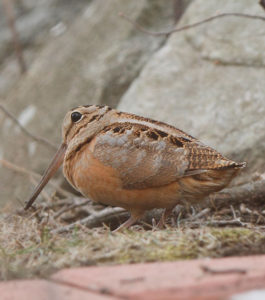By Pam Hunt, NH Audubon Senior Biologist – Avian Conservation
A popular pastime for birders this time of year is watching the courtship display of the American Woodcock (one colloquial name for which is the endearing “timberdoodle”). Each April I offer a woodcock field trip through the Concord Chapter of NH Audubon, and it can be quite popular. Last year, rain forced me to cancel the trip, and yet people still showed up to join me – two from over half an hour away. So yes, woodcock are popular, and my goal here is to help you find them on your own. Take the whole family and make it an evening out in nature!
Although woodcocks nest and forage in wet woods and shrubby areas, in spring the males set up shop in nearby open clearings to attract mates. These display areas can be as varied as recently cut areas, mowed lawns, power line corridors, Christmas tree farms, or old weedy fields – the key thing is an open area of ground that’s not obscured by too much vegetation. Step one is thus to find a few potential spots, and this is best done by being familiar with your local area – driving around a little if needed.
The display starts at dusk, which in late March and early April starts between 7 and 8 depending on date and location. Be in a likely spot just after sunset, wait, and listen. The male starts out with a long series of nasal calls – or “peents” – from some unseen spot in his clearing, and this is the first clue that you’ve found a good location. He’ll do a bunch of these in a row, sometimes for several minutes, and then launch into the second part of his display, the aerial dance. So if you spend a few minutes and DON’T hear any peents, pack up and head to your next spot. Keep this up (it may take a couple of nights) and you’ll eventually be rewarded.
Watch this series of videos to get familiar with what the male looks and sounds like doing this part of the display.
Once you find a peenting male, stick around, as the next phase of the display could happen any time. The male will launch himself into the air and spend the next minute or so flying around, much of the time making twittering noises as air passes through three modified wing feathers. Toward the end of this aerial display, he will descend to the ground – often to the same spot he started at – while initially making chirping calls. The last bit of the descent however, is silent, perhaps to minimize detection by predators.
You can hear these sounds on a different video. And then he starts all over again with the peenting.
Here is an alternative link to train your ear for just the flight sounds.
If you want to actually see a woodcock doing all this, you’ll need to sneak up on it. This is best done by moving toward the source of the peenting while the bird is up in the air – and stopping when you hear the chirping. When it’s on the ground, those big eyes afford it an almost 360 degree view, and the bird is more likely to be spooked. If you’re lucky, you’ll see the bird zip in silently and can then watch the whole show, although note that actually trying to follow a woodcock in display flight is not an easy thing in decreasing darkness. Interestingly enough, woodcock don’t seem to mind you shining a light on them when they’re focused on peenting, so bring along a flashlight or headlamp to get a better look – or better yet, to spot the bird and show it to your friends and family.
A male will display for 30-60 minutes each night (and also just before dawn if you want to get up early). In New Hampshire they are most active from early March through mid-May. They will start earlier on cloudy nights and be more variable on moonlit nights. This means you have plenty of opportunities to get out and experience this fascinating bit of bird behavior. Who knows, maybe you’ll get hooked and start exploring your town to see how many displaying woodcock you can find. Sure beats sitting at home and watching TV!
Email in your photos and video links and we may post them or share them in our special Seek and Find Challenge emails to inspire others to go out and find Timberdoodles!
- ConservationOur work in conservation science:Bald EaglePeregrine FalconNorthern HarrierCommon NighthawkSwallows, Martins and SwiftsWhip-poor-willsGrassland BirdsRusty Blackbird ResearchAmerican PipitsCoastal ShorebirdsThe State of the BirdsMotusFarrar Farm Wildlife Crossing ProjectDragonflies and DamselfliesPollinatorsPhenological Monitoring ProjectRaptor MigrationConsultingPublications & Past Projects
Explore our birding-specific websites:
- Education
- Policy
- Lands
- Centers and EventsCentersEvents
- About Us

